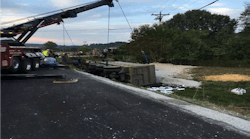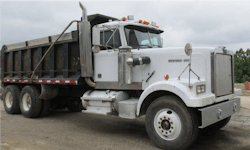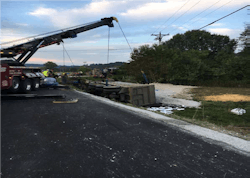The Kentucky Fatality Assessment and Control Evaluation (FACE) Program is tasked with investigating fatalities and making recommendations to ensure they do not occur again. This is one of their recent cases.
At approximately 2:45 p.m., a dump truck driver crossed into Kentucky from Ohio to pick up a load of #55 limestone gravel and deliver it to his assigned destination. The company stated the victim had driven this winding road many times over his 15-year tenure. As he traveled north, he approached a left angle curve.
Tire marks suggested the truck gradually drifted to the right, went off the road and into a small ditch area. The driver attempted to drive out of the ditch 224.10 ft. from the final resting spot of the truck. The deputy sheriff stated the truck driver was traveling over the recommended speed limit of 35 mph. While the speed limit along the state road was posted at 55 mph, the curve was posted at 35 mph with an advisory speed sign prior to the curve.
As the victim entered the curve, neighbors who lived in the vicinity stated they heard the driver trying to apply the truck’s compression release engine brake – commonly referred to as a Jake brake - in an attempt to slow the truck. The deputy stated the Jake brake failed to slow the truck to a safe speed, causing the loaded truck’s center of gravity to shift toward the passenger side, and the driver to lose control of the vehicle.
The truck left the roadway on the passenger side and flipped onto its right side into the culvert 8 ft. below the highway. As the truck flipped, the fuel tank struck a piece of rebar that was protruding from the concrete retaining wall leading to a water drainage tunnel under the highway. The fuel tank ruptured, causing a small fire in the engine that rapidly began to spread as fuel leaked from the tank.
1987 Western Star 4900 series dump truck (Stock photo – Kentucky FACE)
Two neighbors, a husband and wife who heard the crash and saw the smoke from their residence, ran to assist the driver. When they arrived and noticed the fire, the husband desperately tried to pull the unconscious driver out of the burning truck through the front windshield that had become dislodged, while his wife called for emergency assistance and the fire department. The couple stated the driver was thrown and trapped along the passenger side of the truck where the flames were hottest, making it impossible to pull his unconscious body from the burning truck.
Crashed dump truck. (Photo courtesy of witness)
When the flames became too dangerous, the neighbors retreated to safety. Within four minutes, the cab became engulfed in flames. The local fire department arrived at the scene within five minutes of receiving the call and put out the flames. The truck driver was pronounced dead at the scene by the coroner.
Contributing Factors and Recommendations
The cause of death was complications from a motor vehicle collision with post-crash fire.
Occupational injuries and fatalities are often the result of one or more contributing factors or key events in a larger sequence of events that ultimately result in the injury or fatality. Investigation identified the following unrecognized hazards as key contributing factors in this incident:
- Not wearing a seat belt
- Excessive speed
- No guardrail
- Exposed rebar
- Puncture of fuel tank
As a result of this tragic incident and the investigation, Kentucky FACE made the following recommendations for the prevention of future similar incidents:
Recommendation #1
The truck driver was not wearing his seat belt, and as the truck flipped onto its side, he was thrown to the passenger side of the cab. The resulting force knocked the driver unconscious, and he became trapped. By wearing his seat belt, it is possible he would have been conscious and not trapped in the passenger side of the cab, allowing for an attempted self-rescue or better positioning for rescuers to extract him from the burning truck.
Recommendation #2
The truck driver was traveling on a rural highway with several sharp, dangerous curves. Advisory speed signs and curve warnings were posted prior to the curve. Information on the speed of the vehicle was unavailable at the time of this report; however, not following the suggested speed may have caused the driver to lose control. The company stated the driver had traveled this road many times, suggesting that he may have become complacent, and exceeded the recommended speed limit, resulting in the crash. The posted speed limit is intended for passenger vehicles, not large trucks.4 Due to their high center of gravity, commercial motor vehicles should lower their speed before entering a curve in order to negotiate it safely.
Recommendation #3
Guardrails are safety barriers to protect motorists in the event of a crash. According to the Federal Highway Administration, “The guardrail can operate to deflect a vehicle back to the roadway, slow the vehicle down to a complete stop, or, in certain circumstances, slow the vehicle down and then let it proceed past the guardrail.”5 It is possible that guardrails might have prevented the dump truck from leaving the roadway, overturning, and the fuel tank rupturing.
A guardrail system of a TL4, TL5, or TL6 would be best for protecting commercial vehicle drivers, but are cost prohibitive and only used in specialized situations. A TL4 can withstand a single unit truck weighing 22,000 lbs. with a speed of 56 mph and a 15-degree angle of impact. The TL5 and TL6 can withstand 79,300 lbs. with a speed of 50 mph and a 15-degree angle of impact.
A trained engineer uses American Association of State Highway and Transportation Officials (AASHTO) roadside design guide to determine if a guardrail is needed. A slope steeper than a 3:1 warrants the consideration of guardrail, according to the Kentucky Transportation Cabinet Division of Highway Design,
Recommendation #4
Large truck manufacturers should consider an engineering redesign and new placement of fuel tanks within all trucks. With the high number of truck crashes that result in fire, this redesign could save lives as well as equipment. According to the Bunn et al. (2012), large truck vehicle fire rates in Kentucky were significantly increased when compared to light trucks and passenger cars.6 The study recommended the fuel tanks would be better protected within the truck body and not exposed.
For the purpose of this study, ‘large trucks’ include semi-trucks and single unit trucks. According to the FMCSA, single unit trucks “are vehicle configurations designed to transport property, where the cargo carrying capability of the vehicle is integral to the body of the vehicle (i.e. - it does not carry its cargo in an attached trailer)” 7. Dump trucks, including the one featured in this investigation, should be considered for fuel tank redesign.
Recommendation #5
According to the Kentucky Transportation Cabinet’s (KYTC) website page concerning roadway maintenance, the roadway maintenance branch is responsible for several programs, including “Contract maintenance activities such as upgrading existing roadside guardrail, drainage structure maintenance and replacement, concrete pavement repair, slide repair, asphalt patching and other miscellaneous maintenance contracts as required”8. Generally speaking, culverts are hydraulic conduits used to convey water from one side of a highway entrance to the other for the purpose of drainage, making their repairs the responsibility of the KYTC. In this incident, a single piece of rebar measuring approximately 16 inches was protruding from what is referred to as a ‘box culvert’ - a rectangular four-sided concrete structure used in managing and storing storm water. According to the Kentucky Division of the Federal Highway Administration, in instances when small culverts run on a private landowner’s property, it is the responsibility of the landowner to inform the KYTC of structural deficiencies.
The KYTC would then travel to the site and make repairs. An open records request filed by the KY FACE team revealed that no repair request for this particular culvert was submitted. In order to prevent similar incidents from occurring in the future, the KYTC should consider a campaign to educate landowners on how to file maintenance requests via the KYTC website when a road, bridge, or culvert that runs on the owner’s property is in obvious disrepair. Had the landowner informed the KYTC of the protruding rebar, it is possible the repair would have been made prior to the incident and subsequent fire.
Recommendation #6
Prevention through design emphasizes anticipating possible hazards to workers who will use the system and “designing out” those hazards in the design and engineering phase. In this case, the company could invest in electronic stability devices or electronic logging device that attached to the engine and allows the company to view the driver’ speed and location. Although it is hard to project a return on investment for these products, the financial savings come via crash prevention through reduced speeds and decreased likelihood of rollovers.
This case report was developed to draw the attention of employers and employees to a serious safety hazard and is based on preliminary data only. This publication does not represent final determinations regarding the nature of the incident, cause of the injury, or fault of employer, employee, or any party involved.
DeAnna McIntosh currently serves as the safety specialist for the Kentucky Fatality Assessment & Control Evaluation (FACE) Program within KIPRC. With a focus on prevention, her reports analyze a variety of contributing factors to each case, and subsequently make prevention recommendations centered on administrative controls, environmental controls, PPE use and existing safety regulations.


